Recipes & Culinary Uses
How Many Cups of Butter Equals One Stick: A Simple Guide

I’ve always been intrigued by the differences in measurements in the cooking world. For instance, have you ever thought about how many cups are in one stick of butter?
Well, wonder no more! In this article, we’ll explore the relationship between butter sticks and cups, and I’ll provide you with handy conversion factors and a cheat sheet to make your baking adventures a breeze.
So, grab your mixing bowls and get ready to demystify the butter-stick-to-cup conundrum!
Key Takeaways
- Knowing the stick to cup ratio for butter saves time in the kitchen by eliminating the need for complicated calculations.
- The stick to cup ratio ensures accurate measurements, resulting in properly balanced flavors.
- The stick to cup ratio allows for easy scaling up or down of recipes without any confusion.
- Knowing the stick to cup ratio simplifies recipe adjustments for dietary restrictions or preferences.
Conversion Factors for Butter Sticks and Cups
One stick of butter is equal to 1/2 cup. Understanding the standard measurements for butter is essential when it comes to cooking and baking.
Converting butter measurements can sometimes be confusing, but once you know the basic conversion factors, it becomes much easier. For example, if a recipe calls for 1 cup of butter, you can simply use 2 sticks. On the other hand, if you only have butter in stick form and the recipe requires cups, you can easily calculate that one stick is equivalent to 1/2 cup.
It’s important to keep in mind these standard butter measurements to ensure that your recipes turn out just right. Now that we’ve covered the conversion factors, let’s dive deeper into understanding the standard measurements of butter.
Understanding the Standard Measurements
To understand the standard measurements, it’s important to know how much butter is in a single stick. A stick of butter is typically equal to 1/2 cup or 8 tablespoons.
However, when it comes to baking, it’s helpful to be familiar with other butter measurement equivalents. Here are five key conversions to keep in mind when understanding baking measurements:
- 1/4 cup of butter is equal to half a stick.
- 1/3 cup of butter is equal to 5 and 1/3 tablespoons.
- 1/2 cup of butter is equal to one stick.
- 1 cup of butter is equal to two sticks.
- 2 cups of butter is equal to four sticks or one pound.
Understanding these measurements can greatly simplify your baking process and ensure accurate and delicious results.
The Relationship Between Butter Sticks and Cups
When it comes to baking, accurate butter measurements are crucial for a successful outcome. Understanding the relationship between butter sticks and cups is essential for following recipes and achieving the desired texture and flavor.
Converting cups to sticks can be a helpful technique, but it’s important to remember that the accuracy of butter measurements can vary depending on factors such as temperature and density.
Butter Stick Measurements
Do you know how many cups of butter a stick contains? Well, let me tell you. One stick of butter is equivalent to half a cup. It’s a common measurement used in many recipes, but there are alternatives if you don’t have a stick of butter on hand. Here are a few options:
- Margarine: This is a popular substitute for butter and can be used in equal amounts.
- Coconut oil: It adds a hint of sweetness to your dishes and can be substituted for butter in a 1:1 ratio.
- Greek yogurt: It’s a healthier alternative that can be used in baking and cooking, but you may need to adjust the other ingredients.
- Applesauce: It works well in cakes and muffins, and you can replace butter with applesauce in a 1:1 ratio.
- Avocado: It’s a great option for those looking for a dairy-free alternative. Mash it up and use it in place of butter.
Now, let’s talk about common mistakes when measuring butter. One mistake is not properly softening the butter before measuring. It’s important to let the butter come to room temperature so that it can be easily measured and incorporated into your recipe. Another mistake is using the wrong measuring tool. It’s best to use a measuring cup specifically designed for butter or use a kitchen scale for accuracy. Lastly, make sure to level off the butter when measuring. Don’t pack it into the measuring cup, as this can result in too much butter in your recipe.
Converting Cups to Sticks
If you’re wondering how to convert cups to sticks, all you need to remember is that a stick of butter is equivalent to half a cup. This simple conversion can come in handy when you’re following a recipe that calls for butter sticks instead of cups.
Converting butter measurements can be confusing at first, but once you understand the basic conversion, you’ll be able to easily adapt any recipe. For example, if a recipe calls for 1 cup of butter, you would simply use 2 sticks of butter instead. Similarly, if a recipe calls for 3 cups of butter, you would need 6 sticks.
It’s important to keep in mind that different brands of butter may have different sizes for their sticks, so always double-check the packaging to ensure accuracy when converting recipes with butter sticks.
Accuracy of Butter Measurements
To ensure accuracy in your measurements, always double-check the packaging of different butter brands for stick sizes. Common misconceptions about butter measurements can lead to inaccurate results in recipes.
Here are some tips for accurate butter measurements in recipes:
-
Read the packaging: Different brands may have different stick sizes, ranging from 1/4 cup to 1/2 cup.
-
Use a kitchen scale: Weighing the butter can provide the most precise measurement, especially when dealing with recipes that require specific ratios.
-
Measure in tablespoons: If you don’t have a kitchen scale, you can refer to the conversion chart on the package to measure the butter in tablespoons.
-
Soften the butter correctly: Make sure the butter is at the right consistency for accurate measurements. Softened butter should be pliable but not melty.
-
Level off measurements: When measuring butter, use a straight-edge spatula or knife to level off the top for precise amounts.
Calculating Butter Equivalents
I love baking, but sometimes it can be a little confusing when it comes to measuring butter. That’s why I want to dive into the topic of butter measurement conversions.
Specifically, let’s talk about the stick to cup ratio and how to simplify butter equivalencies. Understanding these key points will make it much easier to follow recipes and ensure your baked goods come out perfectly every time.
Butter Measurement Conversions
You can easily convert butter measurements by knowing that one stick of butter is equal to 1/2 cup. This conversion is essential when baking, as many recipes call for specific measurements of butter.
Here are some tips to help you convert butter measurements for your baking needs:
- 1 stick of butter = 8 tablespoons
- 1 stick of butter = 4 ounces
- 1 stick of butter = 113 grams
- 1 stick of butter = 1/4 pound
- 1 stick of butter = 1/2 cup
Knowing these conversions will make it easier for you to follow recipes and ensure that your baked goods turn out just right. So the next time you’re in the kitchen and come across a recipe that calls for a stick of butter, you’ll know exactly how much to measure out.
Happy baking!
Stick to Cup Ratio
When it comes to baking, knowing how much butter to use is crucial. If a recipe calls for a certain number of cups but you only have sticks of butter on hand, it can be confusing. That’s why understanding the stick to cup ratio is so important. Let me break it down for you in a simple table:
| Sticks of Butter | Cups of Butter |
|---|---|
| 1 | 0.5 |
| 2 | 1 |
| 3 | 1.5 |
Using this table, you can easily convert between cups and sticks of butter. For example, if you need 1 cup of butter but only have sticks, simply use 2 sticks. On the other hand, if a recipe calls for 3 sticks of butter and you prefer to use cups, you would need 1.5 cups. This handy conversion tool makes estimating butter quantities a breeze.
Simplifying Butter Equivalencies
Understanding the stick to cup ratio simplifies the process of converting between different measurements of butter. It’s a handy trick that every home cook should know.
So, how many cups of butter is one stick? Well, the stick to cup ratio for butter is 1 stick equals 1/2 cup. This means that if a recipe calls for 1 stick of butter, you can easily convert it to 1/2 cup.
Here are five reasons why knowing this conversion is essential:
- It saves time in the kitchen by eliminating the need for complicated calculations.
- It ensures accurate measurements, resulting in properly balanced flavors.
- It allows for easy scaling up or down of recipes without any confusion.
- It helps in substituting butter with other ingredients if needed.
- It simplifies recipe adjustments for dietary restrictions or preferences.
Handy Butter Measurements Cheat Sheet
To quickly convert butter measurements, refer to this handy cheat sheet for how many cups of butter are in one stick.
When it comes to baking or cooking, precise measurements are key. But sometimes, recipes call for butter in sticks, and it can be confusing to determine how much butter you actually need. That’s where this cheat sheet comes in handy.
One stick of butter is equal to 1/2 cup or 8 tablespoons. So, if a recipe asks for 1 cup of butter, you would need 2 sticks. Similarly, if a recipe requires 1/4 cup of butter, you would use half a stick.
Converting Recipes With Butter Sticks to Cups
It’s helpful to know that a stick of butter is equal to 1/2 cup or 8 tablespoons when converting recipes. Baking with butter sticks versus measuring cups can sometimes be a bit confusing, especially when following a recipe that uses one or the other. However, with a little knowledge and some simple conversions, you can easily adapt any recipe to your preferred measurement.
Here are a few tips to help you convert butter stick measurements for different recipes:
-
When a recipe calls for cups of butter, simply divide the number of sticks required by 2. For example, if a recipe calls for 4 sticks of butter, you would need 2 cups.
-
If a recipe calls for tablespoons of butter, multiply the number of sticks by 8. For instance, if a recipe requires 3 sticks of butter, you would need 24 tablespoons.
-
Keep in mind that butter sticks are typically marked with tablespoon measurements on the packaging, making it easy to measure them out.
-
If you prefer using measuring cups, you can easily convert cups to sticks by multiplying the number of cups by 2. So, if a recipe calls for 1 cup of butter, you would need 2 sticks.
-
Lastly, always check the recipe carefully to ensure you are using the correct measurement. Some recipes may specify butter in sticks, while others may use cups.
Frequently Asked Questions
Can I Use Margarine Instead of Butter in Recipes That Call for One Stick of Butter?
Yes, you can use margarine instead of butter in recipes that call for one stick. However, keep in mind that margarine may have a slightly different taste compared to butter. Additionally, margarine may offer some health benefits.
How Do I Convert a Recipe That Calls for Cups of Butter Into Measurements Using Sticks of Butter?
To convert recipes using butter, start by understanding the measurement of one stick. Then, divide the desired cup measurement by the conversion factor. For example, if a recipe calls for 2 cups of butter, you would need 4 sticks.
What Is the Weight of One Stick of Butter in Grams or Ounces?
One stick of butter weighs 1/2 cup or 113 grams. To measure without a scale, use the water displacement method: submerge the stick in a measuring cup filled with water, and the displaced water will show the weight.
Can I Substitute Oil for Butter in Recipes That Call for One Stick of Butter?
When substituting oil for butter in baking, there are advantages and disadvantages to consider. Oil can provide moistness and prevent drying out, but it lacks the flavor and richness that butter brings. Experimentation is key to finding the right balance.
Are There Any Alternative Measurements for Butter Sticks and Cups, Such as Tablespoons or Teaspoons?
When it comes to measuring butter, tablespoons and cups are commonly used. Converting between the two can be tricky, but remember: "A little goes a long way." So, use caution and precision!
Conclusion
So there you have it, folks! After delving into the world of butter measurements, we now know just how many cups of butter are in one stick.
It’s a mind-blowing revelation that will forever change the way you view your baking recipes. From now on, when you see a recipe calling for a stick of butter, you’ll envision a whole cup of creamy, golden goodness.
It’s as if the butter is magically multiplying before your very eyes, ready to elevate your culinary creations to new heights.
So go forth, armed with this newfound knowledge, and let the buttery adventures begin!
From sneaky childhood butter licks to penning some of our most popular articles, Jamie’s journey with butter has been lifelong. His culinary background gives him a unique perspective, allowing him to craft mouthwatering articles that educate and tantalize equally. Jamie’s travel adventures revolve around finding the world’s best buttery treats when he isn’t writing.
Recipes & Culinary Uses
Gourmet Lobster: Best Butter Poached Lobster Recipe!
Celebrate culinary excellence with our luxurious butter-poached lobster recipe, a decadent dish that will elevate your dining experience to new heights.

Indulge in the epitome of culinary decadence with our exquisite butter-poached lobster recipe that promises to elevate your dining experience to new heights. Customize with garlic, chives, and Sauvignon Blanc for rich flavors. Use the Beurre Monté technique for a velvety sauce and maintain a gentle simmer during cooking. Opt for cold-water lobster tails, thawed and patted dry for even cooking. Serve with Chardonnay or Sauvignon Blanc for a gourmet touch. Pair with herbed risotto or lemon-infused asparagus. Enhance your dish further by choosing quality ingredients and complementary sides. Elevate your cooking and impress with a sophisticated meal.
Key Takeaways
- Choose quality cold-water lobster tails for superior flavor and texture.
- Implement Beurre Monté technique for a velvety sauce.
- Use white wine, garlic, and lemon juice for enhanced flavors.
- Serve with complementary sides like herbed risotto or lemon-infused asparagus.
- Follow precise cooking techniques for tender, gourmet butter-poached lobster.
Recipe Overview
For a delectable dining experience, let's explore the enticing Recipe Overview of butter poached lobster. When preparing butter poached lobster tails, fresh lobster meat is the star of the show. The tails are gently poached in a luxurious bath of butter and poaching liquid over low heat to make sure they remain tender and juicy. The recipe typically calls for unsalted butter, white wine, and a selection of herbs to infuse the meat with rich flavors.
The process of poaching the lobster in butter results in a glossy sauce known as Beurre Monté that elevates the dish to a gourmet level. This classic cooking technique not only enhances the natural sweetness of the lobster but also creates a velvety texture that's truly indulgent.
The simplicity of the ingredients paired with the impressive results make butter poached lobster a go-to dish for special occasions or when you want to pamper yourself with a decadent meal.
Ingredients and Substitutions

Let's talk about the importance of ingredient variety and substitution options when preparing butter-poached lobster.
By exploring different herbs, spices, and flavor profiles, you can tailor the dish to your liking.
Understanding potential ingredient swaps allows for flexibility in creating a customized butter-poached lobster recipe that suits your taste preferences.
Ingredient Variety
Customize the flavors of your butter-poached lobster by experimenting with sliced garlic cloves, chopped chives, or other herbs and spices.
When using cold-water lobster tails for this recipe, make sure to thaw them thoroughly before cooking.
To make butter-poached lobster, start by heating the unsalted butter over low heat. Add the lobster tails and poach them for about one minute until the meat is just cooked through.
For added depth, consider using wines like Sauvignon Blanc, Pinot Grigio, or Chardonnay in your poaching liquid. These wines can complement the delicate flavors of the lobster and butter.
By choosing unsalted butter, you can better control the saltiness of the dish. Feel free to adjust the herbs and spices to suit your taste preferences.
This way, you can create a butter-poached lobster dish that's truly unique and tailored to your liking.
Substitution Options
Consider substituting ingredients in your butter poached lobster recipe to create new and exciting flavor variations. Swap frozen cold water lobster tails with warm water ones for a different taste experience.
Instead of using unsalted butter, try clarified butter or ghee to add a nutty richness to the dish. Experiment with herbs like tarragon, thyme, or basil to customize the flavor profile to your liking. Enhance the savory notes by adding minced shallots or onions to the poaching liquid.
For a deeper flavor dimension, replace white wine with dry vermouth or seafood stock in the recipe. These substitutions can elevate your butter poached lobster dish and offer a fresh take on this gourmet delicacy.
Don't be afraid to mix and match these ingredients to create a buttery lobster masterpiece that suits your palate perfectly.
Cooking Techniques
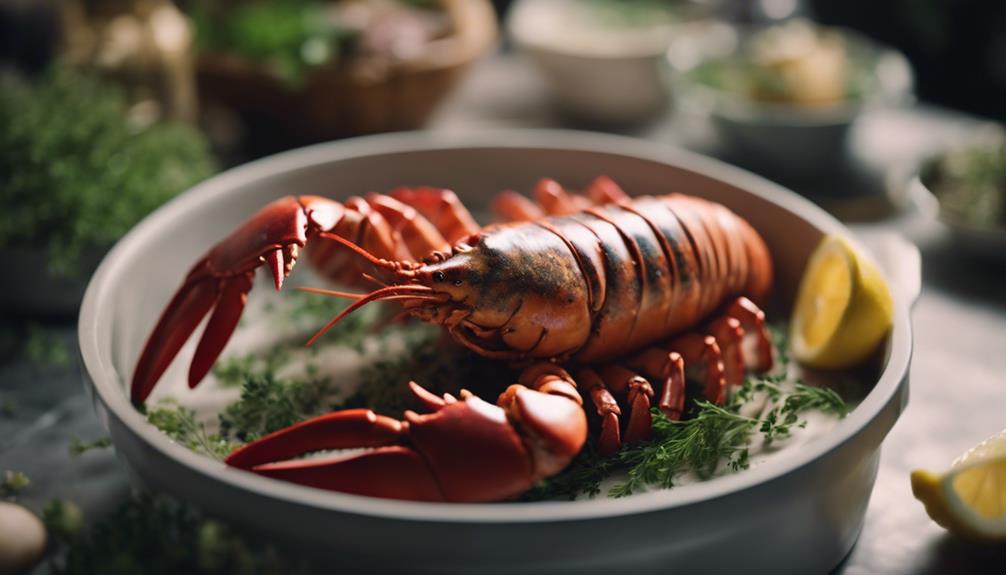
To achieve a velvety sauce for your Butter Poached Lobster Tail, implement the finest technique – Beurre Monté. This method creates a stable emulsion using butter and liquid, enhancing the luxuriousness of the dish.
When preparing the lobster tails, use kitchen shears to carefully remove the meat, ensuring precision and minimal damage. Cook the lobster tails over low heat in the poaching liquid to maintain tenderness.
Thawing frozen lobster tails thoroughly and patting them dry before poaching is essential for even cooking and ideal texture. Keep the poaching liquid at a gentle simmer to prevent overcooking.
Checking the doneness of the lobster tails by observing their opaque appearance helps prevent them from becoming tough and rubbery. By following these cooking techniques, you can elevate your Butter Poached Lobster Tail to a gourmet level, impressing even the most discerning seafood connoisseurs.
Cooking Tips
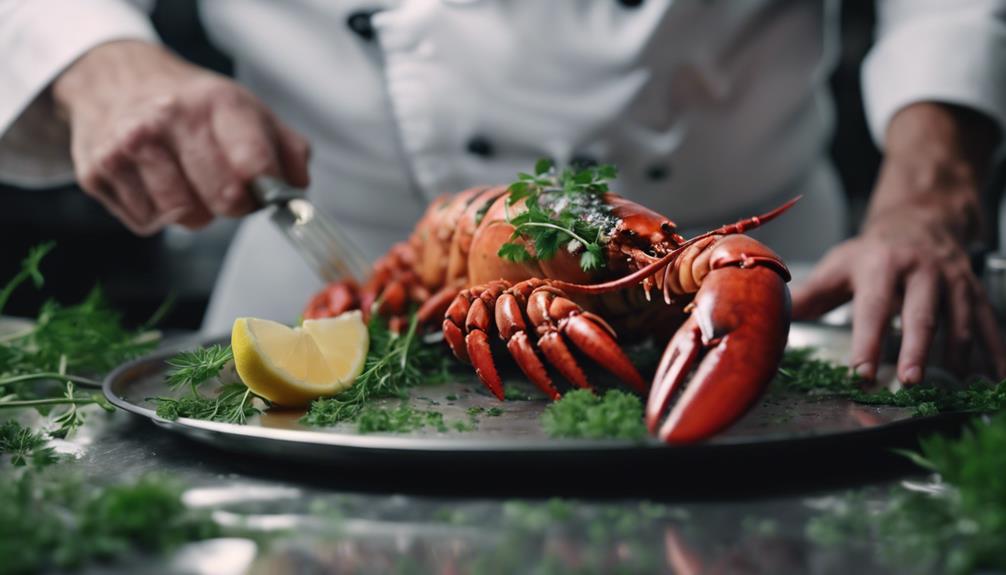
When cooking lobster, using a thermometer guarantees perfect doneness every time.
Thawing frozen lobster tails thoroughly is vital to prevent uneven cooking.
Remember to pat dry the lobster tails before poaching to avoid excess water in the poaching liquid.
Lobster Cooking Techniques
For a perfectly cooked lobster tail, maintain a precise poaching temperature of 180F using a thermometer.
When poaching lobster tails, remember the following tips:
- Thaw frozen lobster tails thoroughly and pat them dry to prevent excess water in the cooking liquid.
- Avoid overcrowding the saucepan to guarantee even cooking of the lobster tails.
- Remove the digestive vein from the lobster tail meat and clean it thoroughly before cooking.
To prepare the Butter Poached Lobster Tail recipe, use unsalted butter, fresh lemon juice, dry white wine, and a pinch of red pepper flakes.
Heat the butter over low heat in a saucepan, add one piece of the cleaned lobster tail at a time, and poach them gently until they reach the desired doneness.
Remember to check the lobster tails a few minutes before the recommended cooking time to prevent overcooking them.
Enjoy the succulent and flavorful lobster tails prepared using these cooking techniques.
Lobster Serving Suggestions
Consider pairing your butter-poached lobster with Chardonnay or Sauvignon Blanc for a delightful wine accompaniment. To complement the succulent lobster, serve it alongside a citrusy quinoa salad or warm baguette slices. Enhance the meal further by adding herbed risotto or lemon-infused asparagus for an explosion of flavors.
When dealing with leftovers, remember to refrigerate them promptly in an airtight container to maintain freshness. When reheating, use a gentle heat setting on a pan. Incorporate a bit of the poaching liquid to keep the lobster moist and prevent it from becoming overcooked. This method will help retain the lobster's tenderness and flavors, ensuring a delicious meal even when reheating.
Serving, Storage, and Reheating
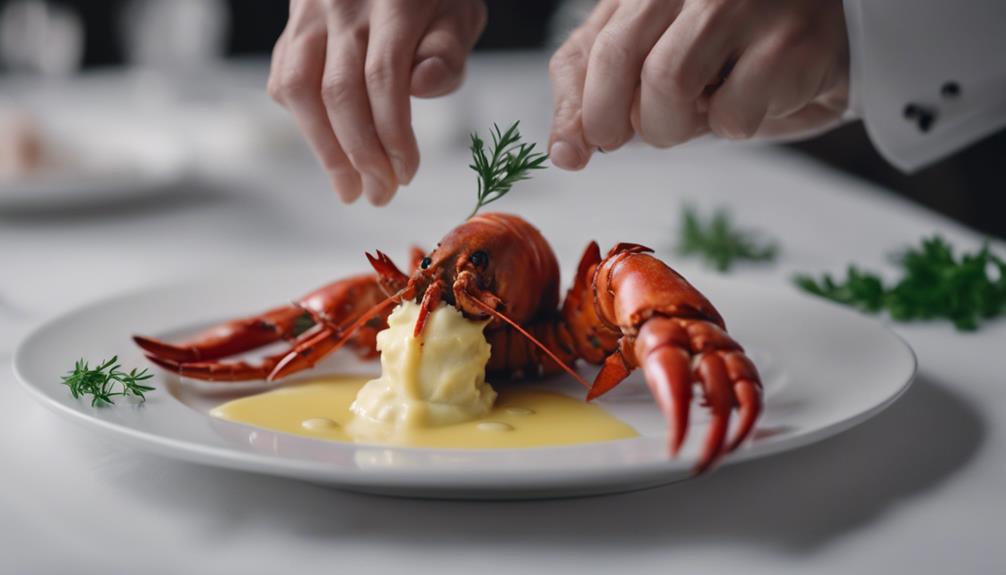
To maintain freshness and flavor, refrigerate any leftover butter-poached lobster promptly in an airtight container.
When it comes to serving, storage, and reheating your delectable lobster, here are some essential tips to guarantee a delightful culinary experience:
- Refrigerate promptly: Store any uneaten lobster in an airtight container in the refrigerator to prevent spoilage and preserve its quality.
- Reheat gently: When reheating, use a pan over low to medium heat to prevent overcooking and maintain the lobster's tenderness.
- Utilize poaching liquid: Incorporate a bit of the poaching liquid when reheating to keep the lobster meat moist and flavorful.
Butter Poached Lobster
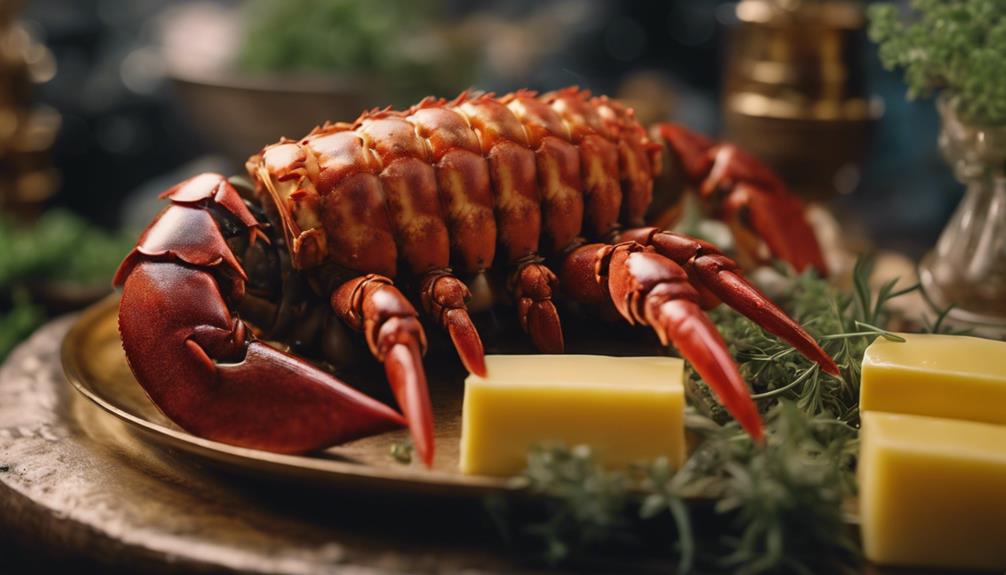
Enhance your culinary skills by mastering-immerse yourself in the exquisite art of butter poached lobster, a decadent dish that elevates the flavors of tender lobster meat with a rich and velvety texture.
Butter poached lobster involves gently cooking juicy lobster in a mixture of butter and white wine, creating a rich and flavorful dish perfect for special occasions. The use of Beurre monté, a French technique, results in a velvety sauce that heightens the delicate texture of the lobster.
The gentle cooking process of butter poached lobster guarantees that the lobster remains tender and juicy, without losing its natural sweetness. The poaching liquid used can also be served alongside the lobster, adding an extra layer of flavor and richness to the dish.
This gourmet delicacy is ideal for those looking to indulge in a luxurious meal at home or impress guests on special occasions.
Elevate Your Cooking

Looking to take your culinary skills to the next level? Elevate your cooking with these expert tips for preparing a gourmet butter-poached lobster dish using uncooked lobster tails and the Beurre monté technique:
- Opt for cold-water lobster tails: Their sweet, delicate flavor and firm texture will enhance your dish, providing a gourmet dining experience.
- Use quality ingredients: Incorporate white wine, garlic, and lemon juice to enhance the natural flavors of the lobster, creating a luxurious and flavorful meal.
- Pair with complementary sides: Serve your butter-poached lobster with herbed risotto or lemon-infused asparagus to further elevate the dish to a gourmet level.
To ensure success, follow key steps like using kitchen shears for precise lobster tail meat removal and maintaining a gentle simmer during cooking. By implementing these techniques and tips, you'll be on your way to impressing your guests with a sophisticated and delicious lobster feast.
Frequently Asked Questions
What Kind of Butter Do Restaurants Use for Lobster?
Restaurants typically use high-quality unsalted butter for butter-poached lobster to control salt levels and enhance lobster flavor. Some may opt for clarified butter due to its higher smoke point. The choice varies based on chefs' preferences and dish style.
What Is the Tastiest Way to Cook Lobster?
When cooking lobster, the tastiest way is to butter poach it. This technique enhances the natural sweetness and delicate flavor of the meat, creating a luxurious, velvety texture. It's a gourmet experience you won't forget.
How to Season Lobster When Boiling?
When boiling lobster, season it with salt and lemon for sweetness. Enhance flavor by adding herbs like thyme or bay leaves. For a kick, throw in garlic, peppercorns, or red pepper flakes. Customize with paprika or cajun seasoning.
What Is Poaching in Butter?
So, what is poaching in butter? Well, it's a gentle cooking method where food luxuriates in warm, melted butter. This technique keeps things moist and intensifies flavors, resulting in tender, silky dishes.
Conclusion
Just like a lobster gracefully glides through the ocean depths, this butter poached lobster recipe will elevate your culinary skills to new heights.
With each succulent bite, you'll feel as though you're diving into a sea of gourmet flavors.
So, don't be afraid to take the plunge and try this luxurious dish – you'll be swimming in deliciousness in no time!
Sunny’s articles radiate enthusiasm, much like her sunny disposition. As our resident “Butter Geek”, she delves deep into the latest butter trends, ensuring our readers are always in the know. Beyond her writing, Sunny’s passion lies in exploring vegan butter alternatives and hosting butter-tasting soirées.
Recipes & Culinary Uses
Creamy Delight: Best Butter Pecan Ice Cream Recipe for Summer!
Yearning for a creamy summer treat that will leave you craving more?
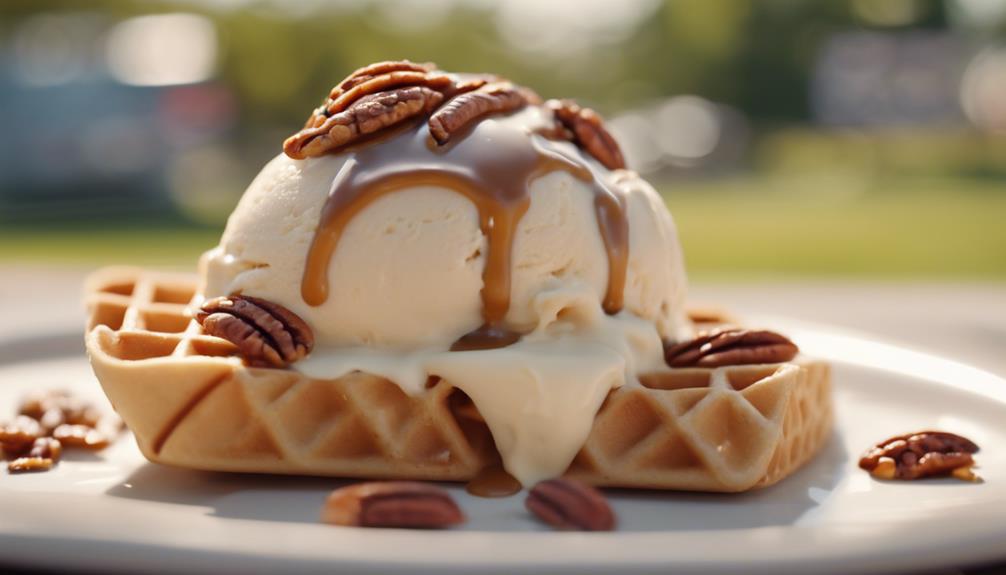
Savor a delicious summer treat with our Butter Pecan Ice Cream recipe. Mix butter, brown sugar, cream, and pecans for a creamy delight. Melt butter, cook pecans, whisk eggs, and blend for a rich flavor. Add pecans, cream, and vanilla, then freeze to perfection. Master this easy-to-follow recipe for a tasty dessert to beat the heat.
Key Takeaways
- Rich and creamy blend of butter, brown sugar, and heavy cream
- Toasted pecans for a nutty crunch and flavor
- Easy-to-follow steps for homemade ice cream perfection
- Customization options with variations like bourbon or chocolate
- Perfect summer treat with a decadent, refreshing taste
Recipe Ingredients for Butter Pecan Ice Cream
To create a delectable batch of butter pecan ice cream, gather the essential ingredients listed in the recipe.
You'll need:
- Butter
- Brown sugar
- Heavy cream
- Pecans
These ingredients combine to bring out the rich and nutty flavors of this classic dessert.
The brown sugar adds a caramel-like sweetness, while the heavy cream contributes to a creamy texture that's essential for a decadent treat.
Pecans, when toasted in butter, provide a delightful crunch and enhance the overall flavor profile of the ice cream.
Cooking Instructions for Homemade Ice Cream
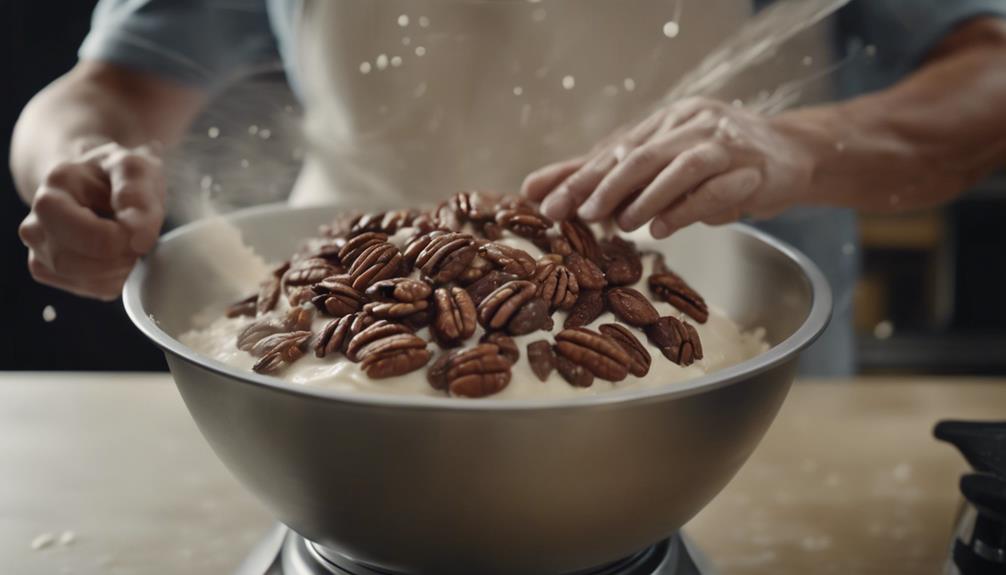
Start by melting butter in a skillet to infuse the pecans with a rich, nutty flavor for your homemade butter pecan ice cream.
Here's a quick guide to help you make this creamy delight:
- Melt butter and cook pecans for flavor.
- Whisk eggs and combine with half-and-half and brown sugar for a creamy base.
- Cook until thickened, then mix with eggs in a bowl.
- Add cream, pecans, and vanilla extract.
- Freeze the mixture in an ice cream maker.
Following these steps will guarantee your homemade butter pecan ice cream turns out rich and delicious.
Remember to carefully adhere to the manufacturer's instructions for your ice cream maker to achieve the perfect consistency.
Enjoy the process of creating this delightful treat that will surely be a hit during the summer months.
Ice Cream Preparation Steps

Mix half and half with brown sugar over medium heat in a large bowl to prepare the ice cream base.
Next, whisk beaten eggs and temper them with the warm milk mixture to create a smooth custard.
Once done, thicken the mixture on low heat, then cool it over an ice bath to achieve ideal texture.
After that, stir in heavy cream, vanilla extract, maple extract, and a pinch of salt for rich flavor.
Remember to refrigerate the mixture for 1 1/2 – 2 hours before churning it into creamy butter pecan ice cream.
This process ensures that the flavors meld together beautifully and the ice cream attains the perfect consistency for scooping and savoring.
Nutritional Information and Tips
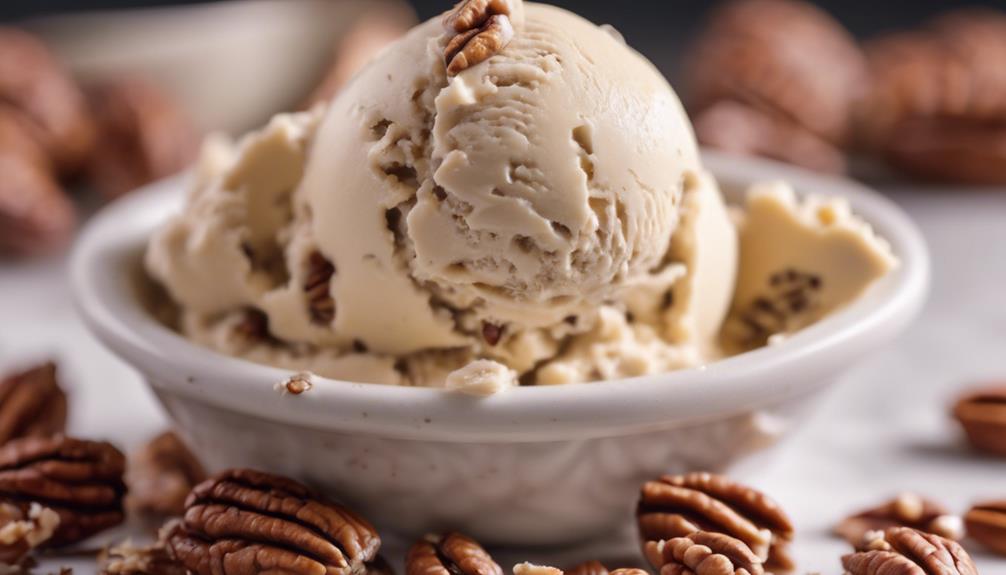
Considering the rich and creamy nature of homemade butter pecan ice cream, it's important to be mindful of its nutritional content and serving size. When indulging in this delectable dessert, remember these essential tips:
- Portion Control: Enjoy in moderation to savor the flavors without overindulging.
- Brown Sugar Sweetness: Opt for a moderate amount of brown sugar to balance sweetness without overwhelming the palate.
- Room Temperature Ingredients: Confirm ingredients like butter and heavy cream are at room temperature for a smoother texture.
- Nutritional Awareness: Be mindful that homemade butter pecan ice cream can vary in nutritional content, so adjust ingredients accordingly.
- Consultation: Seek advice from a nutritionist or healthcare provider for personalized guidance on incorporating this treat into a balanced diet.
Homemade Butter Pecan Ice Cream Variations
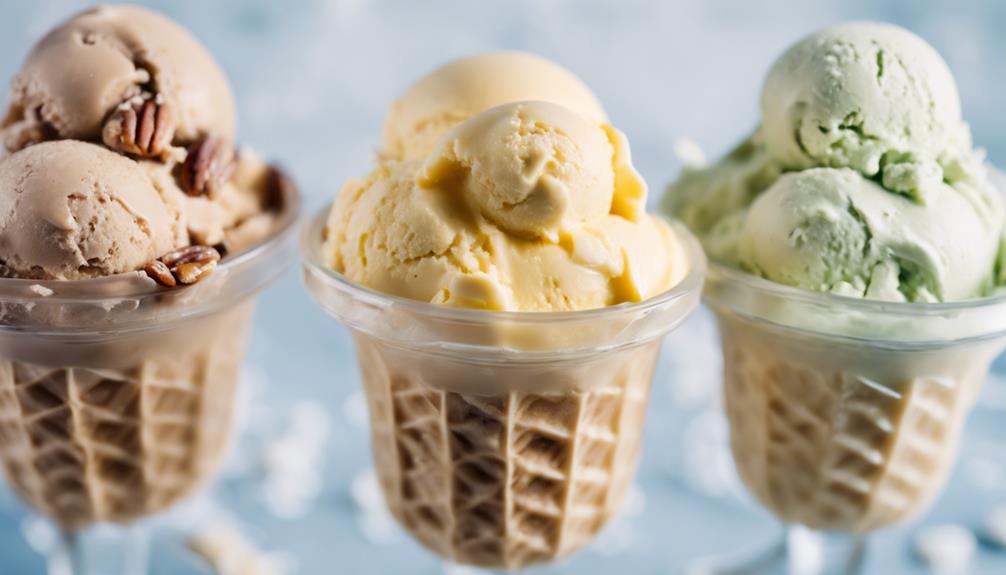
Explore creative twists on traditional butter pecan ice cream by incorporating different nuts, spirits, sauces, chocolates, and dairy-free alternatives.
For a unique flavor, try substituting pecans with walnuts or almonds in the full recipe. Toast the nuts in a separate bowl until browned and fragrant, then chop them finely enough to coat in the ice cream mixture.
To add a boozy kick, mix in a splash of bourbon or rum to the base as you churn the ice cream. For an extra indulgent touch, swirl in caramel sauce or fudge ripple throughout the mixture.
Incorporate chunks of chocolate or chocolate-covered nuts for a delightful contrast in texture, giving each bite a sweet surprise.
If you prefer a lighter, dairy-free option, consider using coconut milk or almond milk as a substitute for traditional dairy products. These alternatives provide a creamy base while catering to plant-based diets.
Experiment with these variations to create a personalized butter pecan ice cream that suits your taste preferences.
Frequently Asked Questions
What Is the Secret to Making Ice Cream Very Creamy?
To make ice cream very creamy, you use a rich base of ingredients like heavy cream, eggs, and sugar. Chilling the base before churning is crucial for a smoother texture. Adding vanilla extract enhances creaminess, and slow churning prevents a dense outcome.
What Flavor Is the Ice Cream in Butter Pecan?
The ice cream in butter pecan is a delightful blend of buttery richness, vanilla sweetness, and maple undertones, perfectly paired with toasted pecans for a nutty crunch. This flavor combination creates a harmonious and indulgent treat.
What's the Difference Between Butter Pecan Ice Cream and Praline Pecan Ice Cream?
In butter pecan ice cream, you'll savor the buttery richness of pecans blended with a creamy base. On the other hand, praline pecan ice cream highlights caramelized sweetness with a swirl of praline sauce for a delightful flavor contrast.
What Age Group Eats Butter Pecan Ice Cream?
You'll find that adults and older individuals, typically in the 30-60 age group, enjoy butter pecan ice cream. It's a favorite among those with a more refined palate, drawn to its rich and nutty flavor.
Conclusion
So there you have it, folks! Whip up this buttery, nutty delight for a taste of summer in every scoop.
Don't cry over spilled milk – grab a cone and enjoy this creamy treat that's sure to satisfy your sweet tooth.
Get churning and indulge in the best butter pecan ice cream you've ever tasted!
Sunny’s articles radiate enthusiasm, much like her sunny disposition. As our resident “Butter Geek”, she delves deep into the latest butter trends, ensuring our readers are always in the know. Beyond her writing, Sunny’s passion lies in exploring vegan butter alternatives and hosting butter-tasting soirées.
Recipes & Culinary Uses
Festive Favorites: Best Peanut Butter Blossoms Recipe for Holidays!
Unleash the ultimate holiday baking magic with the best Peanut Butter Blossoms recipe – an irresistible treat that will elevate your festive celebrations!

Elevate your holiday baking with the ultimate Peanut Butter Blossoms recipe. Cream together peanut butter, butter, sugars, and salt, then add egg and vanilla. Roll dough into balls, coat in brown sugar, bake until golden, then press a Hershey's kiss on top. Adjust baking time as needed. Explore ingredient swaps for a personalized touch. Enjoy with hot cocoa or pair with savory dishes. For more tips, ideas, and customization options, the recipe holds more festive surprises.
Key Takeaways
- Cream together peanut butter, butter, sugars for rich flavor.
- Bake at 375°F for 8-10 minutes for soft, chewy cookies.
- Customize with ingredient swaps like almond butter or maple syrup.
- Pair with savory dishes or hot cocoa for holiday enjoyment.
- Press Hershey kisses onto warm cookies for a classic finish.
Ingredients for Peanut Butter Blossoms
For the classic Peanut Butter Blossoms recipe, gather peanut butter, butter, sugar, an egg, and Hershey's kisses as your essential ingredients.
Peanut butter is the star, offering a rich flavor that blends perfectly with the sweetness of the cookies.
Butter plays a pivotal role by adding moisture and richness to the dough, ensuring a soft and chewy texture.
The sugar not only sweetens the cookies but also contributes to their festive appeal, making them a perfect treat for any occasion.
Finally, the Hershey's kisses on top provide a delightful chocolatey finish that elevates these cookies to a whole new level of deliciousness.
Together, these ingredients create a harmonious blend of flavors and textures that make Peanut Butter Blossoms a beloved classic for holiday baking or any time you crave a sweet and satisfying treat.
Recipe Steps for Peanut Butter Blossoms
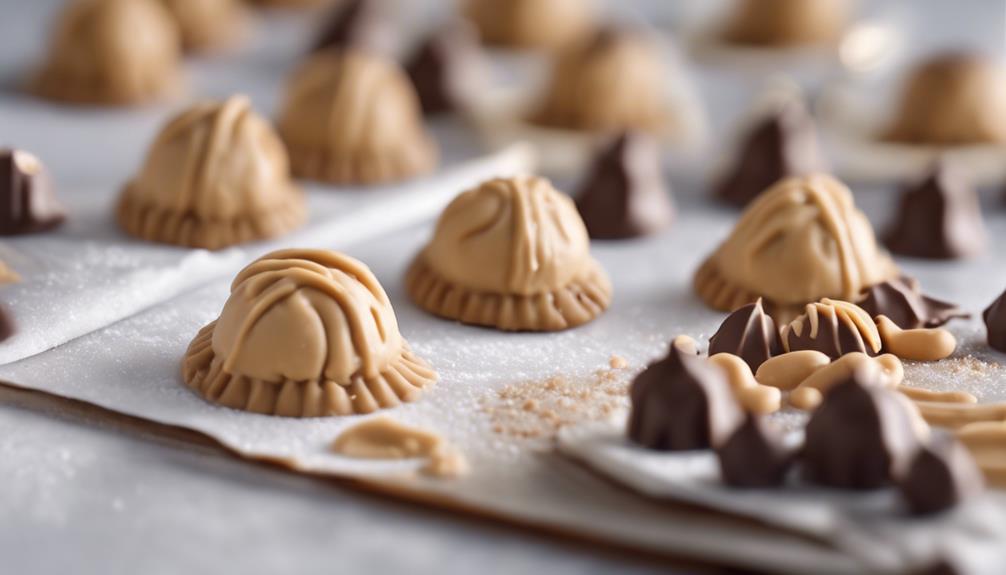
To make Peanut Butter Blossoms, start by creaming together peanut butter, butter, sugars, and salt until light and fluffy.
Next, add in the egg and vanilla extract, making sure to mix well to combine all the ingredients thoroughly.
Then, gradually incorporate the dry ingredients into the wet mixture until a smooth dough forms.
Once the dough is ready, roll it into balls and coat each ball generously in brown sugar.
Place the sugar-coated dough balls on a baking sheet, making sure to leave enough space between them for spreading during baking.
Bake the cookies in a preheated oven until they turn a beautiful golden brown.
As soon as the cookies are out of the oven, press a Hershey's kiss into the center of each cookie gently.
The heat from the freshly baked cookies will melt the chocolate just enough to adhere it to the cookie.
These Peanut Butter Blossoms are a delightful treat perfect for Christmas celebrations!
Pro Tips for Making Peanut Butter Blossoms
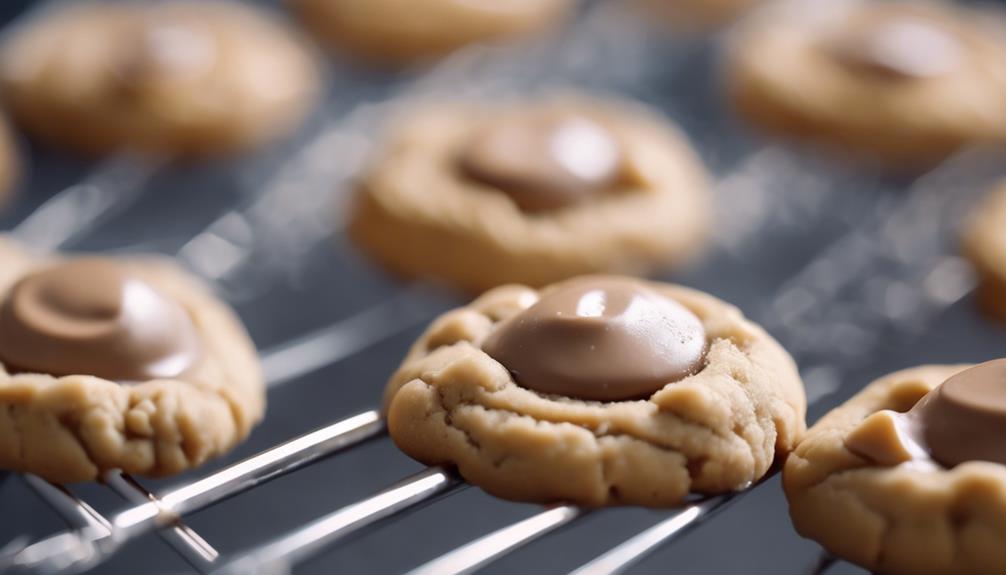
To enhance your peanut butter blossom baking experience, consider adjusting the baking time based on your oven's performance for best results.
Additionally, explore ingredient substitutions to cater to dietary preferences or allergies without compromising the flavor or texture of the cookies.
These pro tips can help you customize your peanut butter blossoms while ensuring delicious outcomes.
Baking Time Recommendations
Achieving the ideal texture for your peanut butter blossoms involves baking them at 375°F for 8-10 minutes. This baking duration guarantees that the cookies have a soft and chewy consistency while allowing the Hershey kisses on top to be softened but not completely melted.
Once out of the oven, remember to press the Hershey kisses onto the cookies immediately to secure them in place for that classic appearance.
For the best outcomes, chill the cookie dough for about 30 minutes before baking. This step helps the cookies maintain their shape and prevents excessive spreading during baking, ensuring your peanut butter blossom cookies are perfectly formed and ready to impress during your holiday baking.
Shortening or extending the baking time can alter the texture of the cookies. A quick bake of 6-8 minutes produces softer and chewier cookies, while longer baking times yield a slightly crispier consistency. Stick to the recommended 8-10 minutes for the best soft and chewy peanut butter blossoms.
Ingredient Substitutions
Consider incorporating different ingredients to elevate the flavor and nutritional profile of your peanut butter blossoms. For a healthier option, swap out shortening with unsalted butter to achieve a unique texture and taste in your cookies.
Try using natural peanut butter instead of creamy to add a wholesome twist to the classic recipe. If you're looking to reduce the glycemic impact, substitute brown sugar with coconut sugar in your baking. For a natural sweetener alternative, replace regular granulated sugar with maple syrup in the cookie dough mixture.
Additionally, for a distinct flavor experience, experiment with almond butter as a substitute for peanut butter in your blossoms. These ingredient substitutions can bring a new dimension to your peanut butter blossoms, making them not only delicious but also tailored to your dietary preferences.
Upgrade your baking game this holiday season with these creative twists on a beloved recipe!
Serving Suggestions for Peanut Butter Blossoms

Enhance the enjoyment of your peanut butter blossoms by pairing them with savory dishes like lasagna tortellini soup for a satisfying meal. These classic cookies also complement family-friendly dinners such as easy ground beef shepherd's pie and creamy broccoli cheddar soup, making for a delightful combination. The holiday season calls for cozy treats, and the sweet nuttiness of peanut butter blossoms pairs perfectly with a warm cup of hot cocoa. Whether you're participating in a cookie exchange or looking for a festive touch to your holiday dessert spread, consider rolling the cookies in red, green, and white sugar sprinkles to add a pop of color and fun.
| Serving Suggestions | Pairing Ideas |
|---|---|
| Lasagna Tortellini Soup | Comforting and hearty meal alongside the cookies |
| Easy Ground Beef Shepherd's Pie | Delicious combination for a family dinner |
| Creamy Broccoli Cheddar Soup | Perfect accompaniment to the nutty cookie flavors |
12 Days of Christmas Cookies Recipes
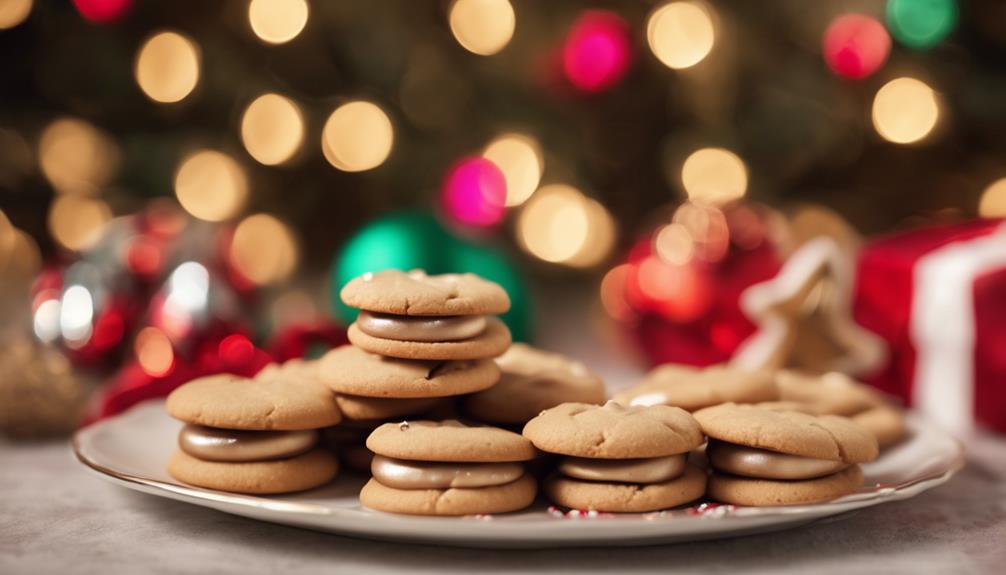
Indulge in a variety of delightful Christmas cookie recipes each day during the holiday season. One standout choice is the classic Peanut Butter Blossoms. These holiday cookies feature a peanut butter base topped with a Hershey's kiss, making them a beloved treat for cookie exchanges and festive gatherings.
The process of making these cookies is simple yet rewarding. Start by rolling the dough balls in sugar before baking to add a sweet crunch to each bite. The combination of rich peanut butter flavor and the chocolatey goodness of the Hershey's kiss creates a perfect balance of sweetness.
When enjoying these Christmas cookies, consider pairing them with a glass of milk for a classic and satisfying treat.
Whether you're baking them for your family, a cookie exchange, or a holiday party, Peanut Butter Blossoms are sure to be a hit. Make each day of the holiday season a little sweeter with these delicious cookies.
User Engagement Features
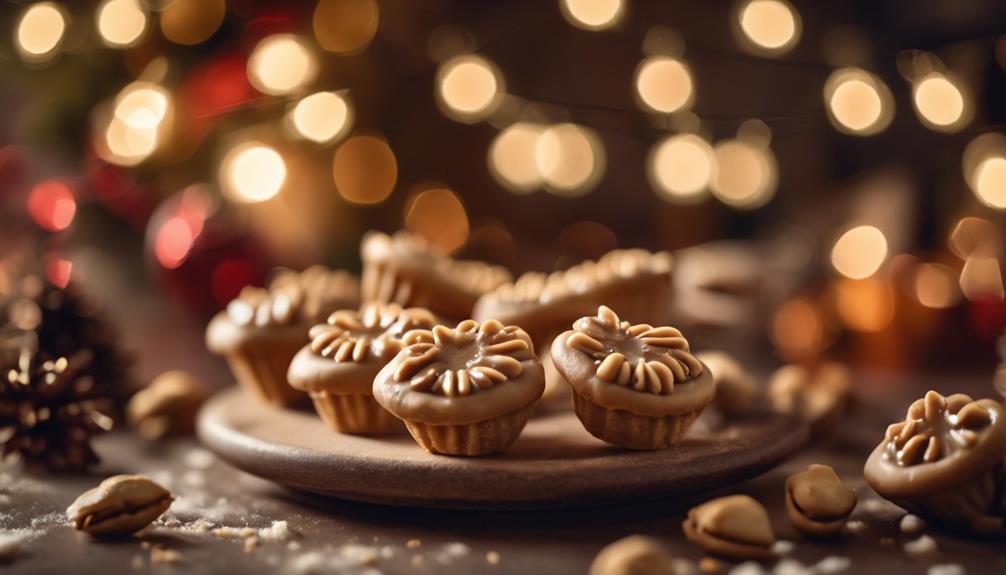
Let's talk about how user interaction features and personalization options enhance your experience with the Peanut Butter Blossoms recipe.
You can engage with others by leaving comments and sharing your results, creating a sense of community around this holiday treat.
Personalization options like name and email entry fields help tailor the experience to your preferences, making it more engaging and enjoyable.
User Interaction Features
Utilizing user engagement features on the website allows for increased participation and feedback from visitors. The comment section enables users to interact with each other and provide valuable feedback on the Peanut Butter Blossoms recipe or share their experiences with Hershey's kisses. By incorporating a reply option, users can engage in conversations, fostering a sense of community around baking these delightful peanut butter cookies.
Moreover, the inclusion of name and email fields not only allows for personalization but also facilitates communication between the website and its visitors. This data storage feature guarantees that users can conveniently access their information for future visits, enhancing their overall user experience.
These user engagement features play an essential role in creating an interactive platform where users can engage, provide feedback, and communicate effectively. Such interaction not only enriches the user experience but also encourages visitors to actively participate in the community surrounding the Peanut Butter Blossoms recipe.
Personalization Options
Enhance your website's user engagement by incorporating personalized options such as commenting, replying, and sharing feedback on the Peanut Butter Blossoms recipe. This level of user interaction not only fosters a sense of community building but also encourages customization and feedback. By allowing users to share their thoughts, results, and experiences with the festive favorites, you create a more engaging and interactive user experience. Additionally, providing users with the option to save their data for future visits and encouraging them to tag @preppykitchen and use #preppykitchen when trying the recipe further enhances their engagement.
| Personalization Options | Description | Benefits |
|---|---|---|
| Commenting | Users can leave comments on the Peanut Butter Blossoms recipe, sharing their thoughts and experiences. | Fosters community building and user engagement. |
| Replying | Users can reply to comments and engage in discussions with other users about the recipe. | Encourages active participation and interaction. |
| Feedback Sharing | Users can share feedback on the recipe, providing valuable insights for improvement. | Enhances user experience and customization. |
Additional Information

You may find it interesting to know more about the history of the Peanut Butter Blossoms recipe and its cultural significance during the holidays.
- The Peanut Butter Blossoms recipe's popularity is backed by IRI MULO data, making it a sought-after choice for holiday baking.
- Copyright for this beloved recipe belongs to The J.M. Smucker Company, a reputable name in the food industry known for quality products.
- These delightful cookies aren't only perfect for serving at holiday parties but also make excellent gifts due to their festive appeal.
Frequently Asked Questions
Why Are My Peanut Butter Blossoms Dry?
If your peanut butter blossoms are dry, it could be due to using too much flour, overbaking, using natural peanut butter that requires stirring, or not enough butter/shortening. Guarantee precise measurements and follow the recipe closely to maintain moisture.
Why Did My Peanut Butter Blossoms Go Flat?
When making peanut butter blossoms, going flat happens due to overmixing, too much flour, insufficient chilling, or low oven temperature. Remember to avoid these pitfalls. Preheat the oven properly and follow the recipe for perfect blossoms!
What Is America's Favorite Christmas Cookie?
America's favorite Christmas cookie is Peanut Butter Blossoms. Loved for their peanut butter-chocolate combo and nostalgic Hershey's Kiss center, these easy-to-make treats are a holiday staple at parties and gatherings. They're a must-have during the festive season.
What Is Baskin Robbins Peanut Butter Blossom?
You asked about Baskin Robbins Peanut Butter Blossom. It's a delectable seasonal ice cream flavor featuring creamy peanut butter ice cream with a ribbon of more peanut butter and chocolate cookie pieces. Indulge in this festive treat!
Conclusion
Indulge in the warm, gooey goodness of these peanut butter blossoms this holiday season. With the perfect blend of creamy peanut butter and rich chocolate, these cookies are sure to bring joy to your festivities.
Picture yourself surrounded by loved ones, sharing laughter and memories as you enjoy these delicious treats. Let the aroma of freshly baked cookies fill your home and create a cozy, festive atmosphere.
Happy baking and happy holidays!
Sunny’s articles radiate enthusiasm, much like her sunny disposition. As our resident “Butter Geek”, she delves deep into the latest butter trends, ensuring our readers are always in the know. Beyond her writing, Sunny’s passion lies in exploring vegan butter alternatives and hosting butter-tasting soirées.
-

 Recipes & Culinary Uses2 months ago
Recipes & Culinary Uses2 months agoHow Many Sticks of Butter Equals a Pound: A Handy Guide
-

 Shopping Guides1 month ago
Shopping Guides1 month agoWhere to Buy Raw Butter
-

 Recipes & Culinary Uses4 weeks ago
Recipes & Culinary Uses4 weeks agoMake Homemade Butter from Milk at Home
-

 Recipes & Culinary Uses4 weeks ago
Recipes & Culinary Uses4 weeks agoMake Creamy Butter From Buttermilk
-

 Butter Tips and Tricks3 months ago
Butter Tips and Tricks3 months agoHow Long Can You Use Butter After the Expiration Date?
-

 Recipes & Culinary Uses2 months ago
Recipes & Culinary Uses2 months agoMake Your Own Homemade Spray Butter
-

 Butter Tips and Tricks3 months ago
Butter Tips and Tricks3 months agoHow Much Butter to Use Instead of 1/3 Cup Oil
-

 Butter Tips and Tricks3 months ago
Butter Tips and Tricks3 months agoHow Many Calories Are in a Stick of Butter: A Comprehensive Guide





















